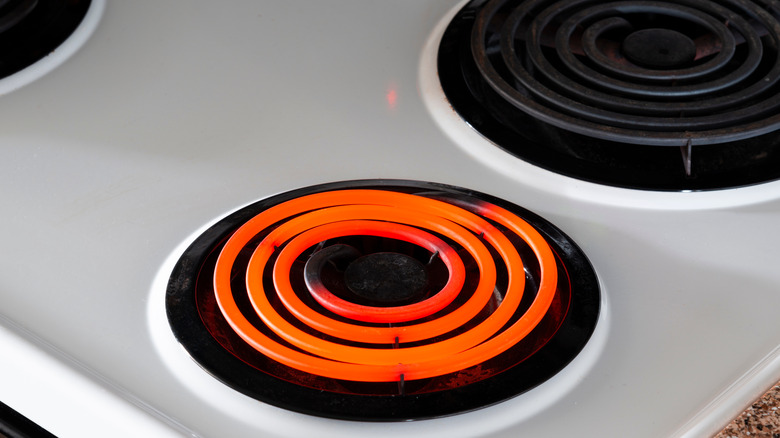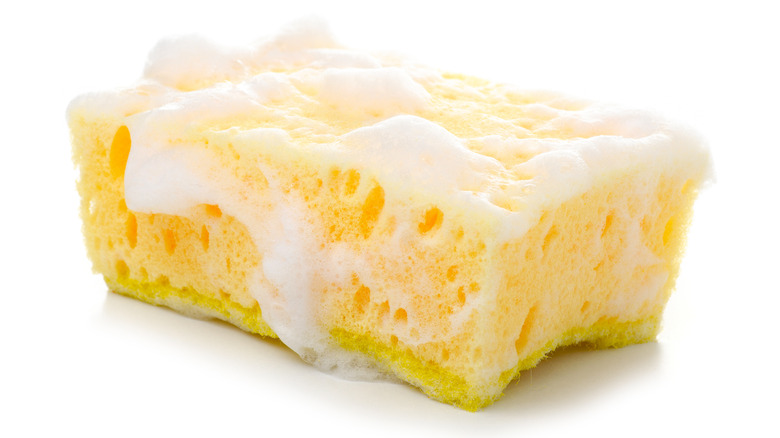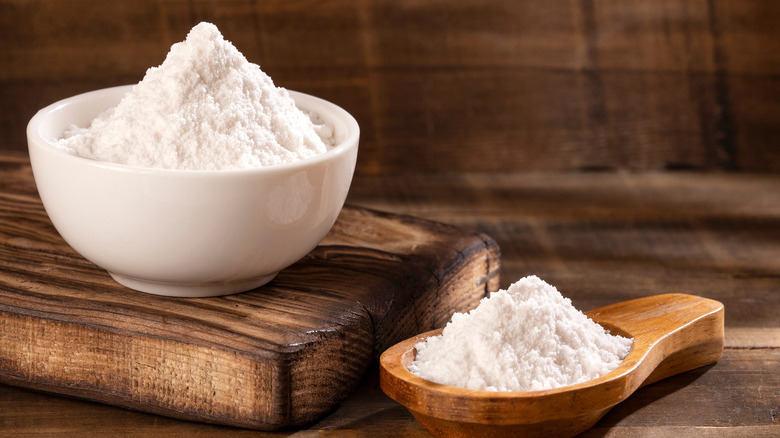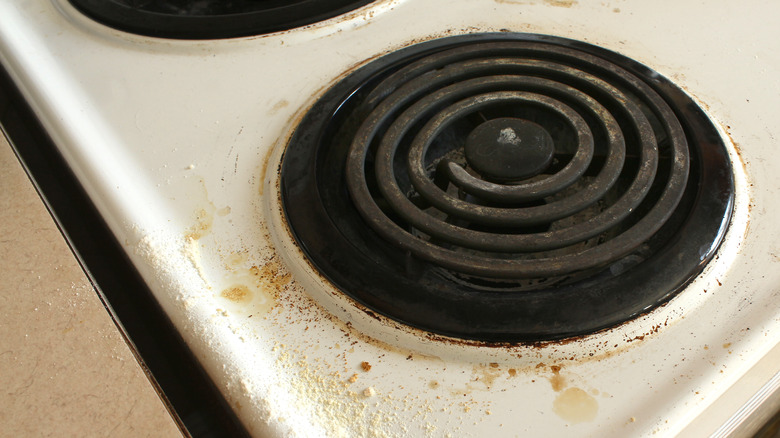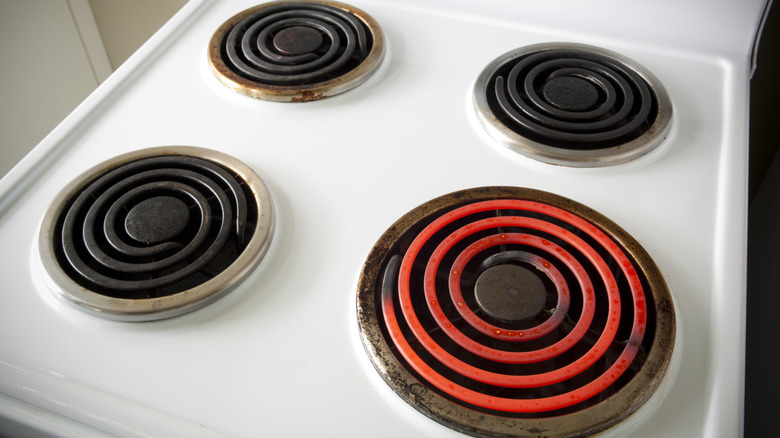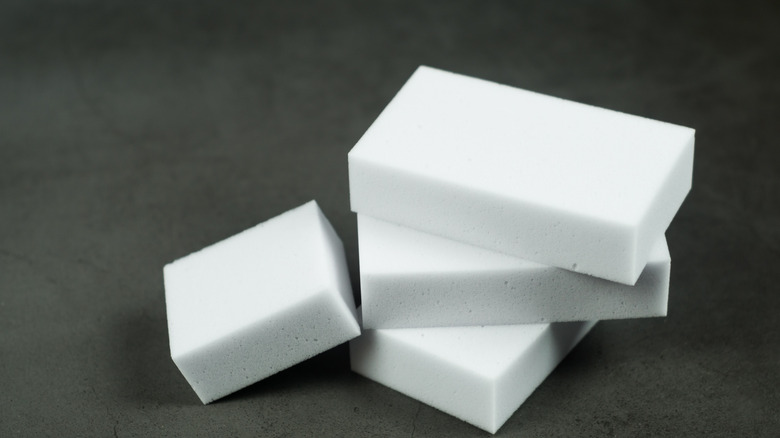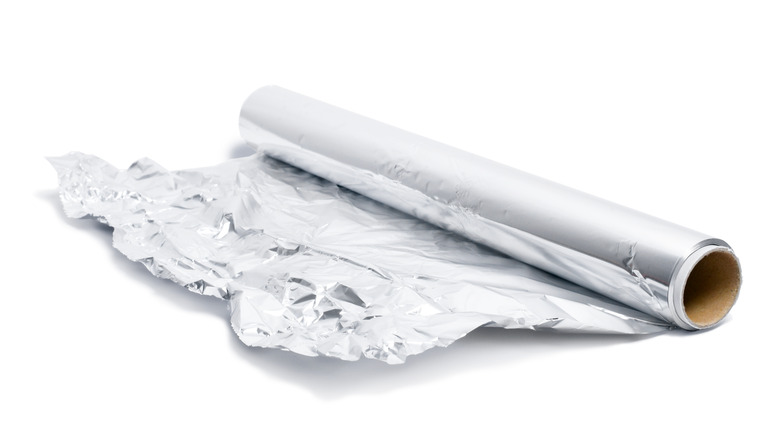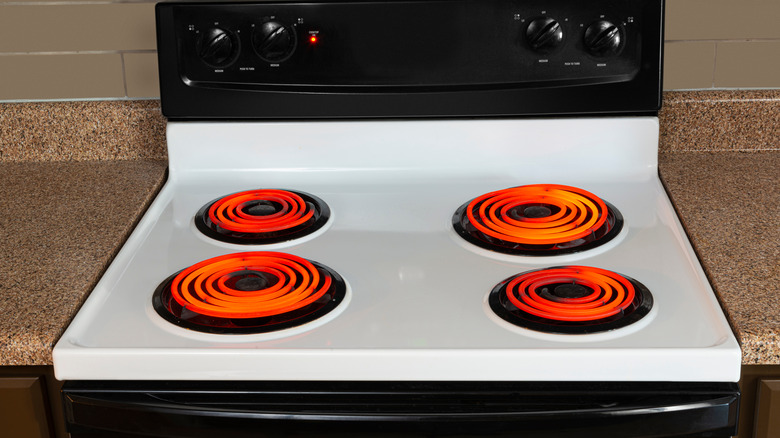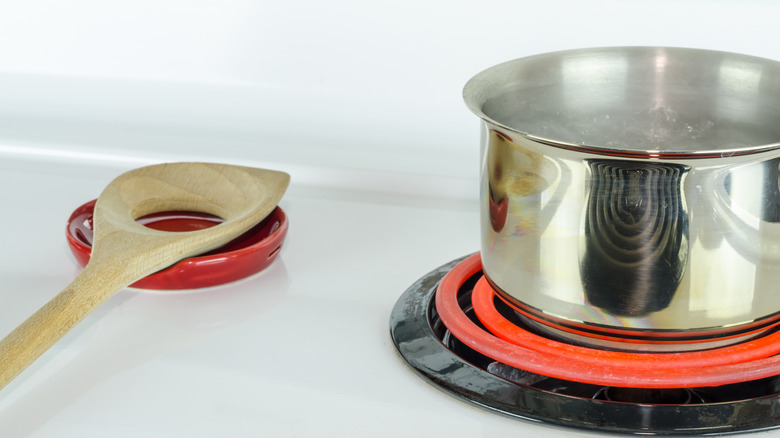8 Easiest Ways To Clean Electric Stove Burners
Standard electric stoves feature coils that cook your food. Unfortunately, messing them up is easy, as a pot can boil over and stain the area, or as you stir a recipe the spoon splatters bits of sauce everywhere — well, you get the idea. We've all been there. To that end, cleaning this area is imperative, and the quicker you do it the easier the job is. If you leave the remains of your dinner on the burners, the next time you cook on its surface sparks or smoke could appear, according to The Spruce. Plus, you don't want stains to set.
A general electric stove burner cleanup takes minutes; allow the stove to cool and give it an easy wipe down with a cleaning cloth and mild dish soap, offered Today. Sometimes the dirt and grime requires a deeper attempt, but even that shouldn't take more than 20 minutes. Here are eight easy ways you can get those electric stove burners sparkling clean.
1. Use dish soap and water
Some stains only need a gentle touch. To that end, once your oven has cooled, gather a microfiber cloth, a sponge, and a mild dish detergent that contains grease-disintegrating properties, said Today. First, take the cloth and dampen it with the water and swab it along the coils to remove any food residue. You can then use the dish soap and hot water mixture to clean any of the exposed reflector pans. You can even try peeking under the cooktop and see if any spillage progressed to that section. If so, you'll need to wipe it down with the soap and sponge. Do not get the inside of your stove wet — all electrical pieces should stay dry, stated Proline Range Hoods. After gently cleaning everything, take a fabric or paper towel and dry everything thoroughly.
Regularly cleaning your burners should be part of your daily kitchen maintenance. You can do it the same time you take a sponge or cloth to your stovetop. Doing a little bit each day will save you from a big job later on, and will keep the area sparkling.
2. Apply a baking soda paste
While cleaning your stovetop with detergent and water, you might find the need for something stronger. To get at those tough stains, you can add a scrubbier sponge to your repertoire of cleaning materials, said Proline Range Hoods. Heating coils are stronger than you think — they won't scratch even if you use something like baking soda. A combination of baking soda with your nubbed sponge is terrific for removing that burnt food.
A good DIY cleanser can also be made from one part water and three parts baking soda. Mix until you make a paste, then coat this over your coils for 15 minutes before spraying a bit of vinegar on top, which will offer a satisfying sizzle as it cleans. When it stops making those bubbling noises, wipe the burners clean and examine your electric heating coils. They should be pristine.
If they are not quite there, try using the scouring sponge with baking soda one more time. That should get everything out.
3. Remove heater coils for deep cleaning
Often, your electric stove burners need more than just a rub down — especially if the undersides of the coils are marked with food residue from past meals. Then you'll need to take off the burners to get to those hard-to-reach spaces. Do this only after the oven is cool, as noted by The Spruce.
Usually there are three ways to remove the coils: Unplug the two prongs from the stove's socket fittings, squeeze them together to detach, or unfasten the mounting collars and move coils aside. When in doubt, check your manufacturer's instructions. Be careful when doing this; you don't want to bend the prongs and render them useless.
Now you can clean the entire cooktop. Start by using your dish soap and water solution and wipe everything down. Never try to clean the coils by immersing it them water, as the liquid can ruin the device's electric system. When the coils are done, don't forget your drip pans. When you are all finished, re-plug the prongs into their sockets. Voilà! Clean stove.
4. Change coils that don't work
Part of maintaining your electric stove might include replacing burnbers — not because they are dirty necessarily, but because they don't work correctly or at all (although if you have the champion of stains on your coil and nothing removes it, this could be a way to go).
Replacing a problematic coil isn't that difficult, according to Sears Parts Direct. The first step is to pull the stove from the wall and disengage the power cord. You never want to do this while electricity still runs through your stove. You also want the stovetop nice and cool, so wait an hour or so after using to ensure you will not get burned.
Next, remove the prongs of the coil from the mounted block. You should be able to pull the burner right from the receptacle under the stove's cooktop. Then, take the new coil and fasten it into the receptacle. Re-affix drip pans or any other of the stove's elements. When everything is restored, you can plug the stove back in and use as usual.
5. Use a Magic Eraser
The Magic Eraser is some sort of cleaning sorcery. Since hitting the market in 2003, it has made cleaning dirty spaces almost fun. There is something about taking the flexible sponge in your hand, wetting it, and then seeing it skim away the grime you had rubbed at with a cloth for the past five minutes (via Family Handyman).
The secret is that the eraser contains melamine foam, which uses formaldehyde-melamine-sodium bisulfite copolymer. This makes it an amazing stain remover because it can perform like fine sandpaper, essentially lifting the stains from the object. They are also non-toxic. The one downside of these sponges is the abrasiveness can wear away some materials, so don't use the eraser on anything that is polished or easily scratched like stainless steel. You'll want to do a test patch before attacking bigger areas.
To clean your stovetop burners, just wet the sponge and rub at the stain, suggested One Crazy Mom. Then dry with a microfiber cloth. If a mark still exists, try spraying a bit or vinegar on the blemish, and let it sit for a few minutes before mopping it up with a cloth. Now use the Magic Eraser to polish the surface.
6. Use tinfoil
Aluminum foil, the kitchen staple for cooking and wrapping up food, has more uses that you might think. It is also a terrific cleaning hack, according to All Recipes. "Aluminum foil is great at scrubbing food build-up off of your grill grates safely," said Arie Hazan, founder and head chef of Arie's Catering in Columbus, Ohio to the publication.
In fact, you can use foil to clean grills, pots, pans, and your electric stove coils. "Wad up a ball of aluminum foil, lightly douse your grill grates with water and start scrubbing," Hazan says. "We cater grilled dinners for 100 guests or more at a time, and this cleaning hack helps cut our post-grilling clean up time down drastically." You can also use aluminum foil to line your burners to keep stains at a minimum. This prevents drips from hardening into your stovetop. If you opt to do this though, make sure that you swap them out when they get dirty.
Homeowner Repair asserts that the tinfoil cleans your coils so well that they will shine — almost like new ones.
7. Use heat
Did you know that your electric stove burners have a self-cleaning feature? However, it is not as easy as the one in ovens, in which you lock your oven and the oven heats to 880 degrees Fahrenheit for several hours, decomposing your food remains and leaving you a few ashes to mop up after the oven cools (via GE Appliances).
This methodology requires you to first tackle that grease and gunk with a slightly wet, lint-free cloth before removing everything off your stove, such as your teapot, cookware, etc. Then turn those burners as high as they go, and leave them on for several minutes. You are essentially performing the same function a self-cleaning oven does — the intensity of the heat should burn the food residue away. After three minutes, turn the stove off and allow it to cool. You should be able to take away anything that lingers with a sweep of a cloth once cooled, per Bob Vila.
8. Try a degreasing cleanser
Grease can offer a challenge when cleaning your electric stove burners, and sometimes adding a commercial cleaner to your mix of tools can help you out. For one, something like Simple Green can cut through that waxy residue clinging to your stovetop's surface, offered Kitchen Sanity. Additionally, a commercial oven cleaner, suggested Tips Bulletin, is a terrific way to clean up removable parts of a stove. Since some of these emit fumes, you'll want a well-ventilated location to do your work in. After applying the cleaner, it should sit for a bit; consult the bottle to see what works best with the cleaner you have chosen. Next, wash everything with a hot water/soap combination, administering it with a sponge or rag.
Your stove's drip pans can also benefit from something stronger, such as ammonia. The Spruce suggests donning rubber gloves and putting the cool drip pans in 1 gallon resealable plastic bags. Add 1/4 of a cup of the substance into the bag; because it's a powerful cleaner, you do not need to immerse the item. Seal the bag and let it sit for a minimum of 12 hours. When you open the bags afterward, be careful since the fumes can be overwhelming. You should wash these in hot water with dish soap, then dry and replace them. Your electric stove will be the envy of the neighborhood ... well, maybe that's overstating it a bit, but it will be nice and clean.
